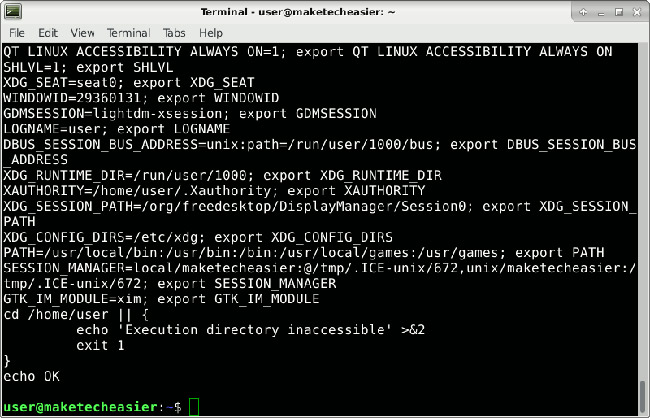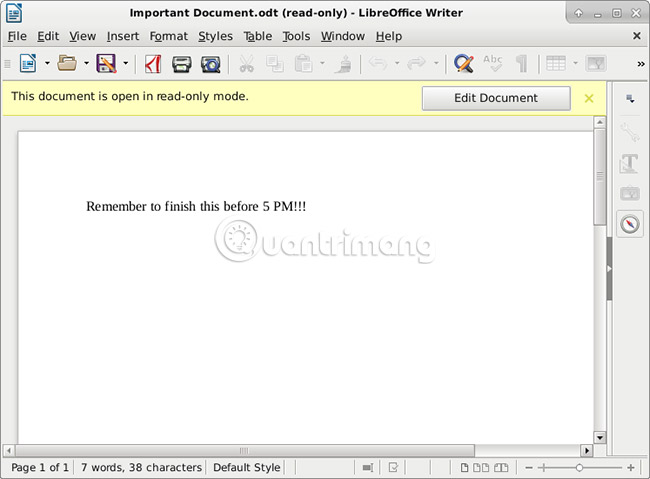How to schedule Linux commands with 'at'
If you have to manage a 'busy' server, you have to wait for an appropriate time to restart the server (ie when people don't use it). This appropriate time is probably at dawn. But this is inconvenient! Does the administrator have to wake up early just to restart his server? With Linux, automating such a simple task is easy with the 'at' utility .
This utility is very easy to use. Users only need to give time and date as command line parameters, then enter one or more commands to execute.
On a server, it is useful to have such a program because users often want the server to perform unattended actions. But even on desktops, at can also be a very convenient tool. For example, suppose you download a very large file. You can schedule your PC to turn off late at night. In addition, users can request at remind them of what to do. Many actions can be scheduled with the appropriate command line tools and options.
Schedule tasks with utilities at Linux
- How to install at different Linux distributions
- Enable the auto-start daemon at
- How to specify the date and time to schedule at commands
- How to use the at command
- View and / or delete scheduled jobs
- Schedule at to run graphics applications
How to install at different Linux distributions
On Debian or Debian-based distributions, run:
sudo apt install at 
On Fedora, run:
sudo dnf install at To install at on Arch Linux, enter the command:
sudo pacman -S at And, on openSUSE, enter the command:
sudo zypper install at Enable the auto-start daemon at
Some distributions will automatically activate daemon boot at boot time. But some other distributions do not. Please check with:
systemctl is-enabled atd.service 
If the result is 'disabled', then enable it with:
sudo systemctl enable atd.service And start the daemon:
sudo systemctl start atd.service How to specify the date and time to schedule at commands
Users can use one of the following forms.
1. Run the command after the specified number of minutes, hours, days or weeks.
at now + 10 minutes at now + 10 hours at now + 10 days at now + 10 weeks 
2. Run at an exact time:
at 23:10 If it is 12:00, and you run:
at 11:00 The order will run tomorrow, at the time specified.
3. Run at the specified time and date:
at 12:00 December 31 Other ways to determine the time and date can be found in the online utility manual. (link reference: https://linux.die.net/man/1/at)
How to use the at command
As you can see, after specifying the scheduled time, a command prompt like the following image will appear:

Here, users only need to enter the commands they want to run. They will be executed under the current user name. Enter the command you want to run at a specified time and press Enter. If you want to run the next command, repeat the same process. When done, press Ctrl + D. will be displayed when the keys are pressed, followed by the time the command (s) will be executed.
If you want to run commands that require root access, do not use sudo. Remember, the command will run without supervision, so sudo will not work because no one has entered the password. Instead, first log in as the root user:
sudo -i And then use the at command as usual. Now, all commands will be executed with root privileges, instead of regular users.
After scheduling the order, enter:
exit This command will log you out from the user root account.

In the example in this screenshot, the shutdown is scheduled for two minutes. Users can adjust it to suit their own needs.
If the computer is turned off before a scheduled job has a chance to run, that task will run at the next boot (if the time is set for it to be over). For example, if the work schedule is scheduled at 3 pm, turn off the computer at 2 pm and turn on the power at 4 pm, the work will run at 4 pm.
View and / or delete scheduled jobs
Users can view jobs ordered by order:
atq Or command:
at -l 
To see which commands are scheduled on a job, use the prefix number of the job.
at -c 22 
The final output lines will show the user the scheduled commands.
To delete a job, use its prefix number as follows:
atrm 22 Schedule at to run graphics applications
First, find the current display variable value:
echo $DISPLAY Usually, it will be : 0.
Schedule to run at. In the at prompt, set the DISPLAY variable to the previous value ( export DISPLAY =: 0 ) and run the desired graphics application.

The commands used in the previous screenshot will result in the following results.

Now, the graphics application will prompt users for an important job better than the phone alarm.
Use at very easy. The harder part is finding a creative way to perform an action you desire. But you can do whatever you want, like starting to download, close the program, put the computer on standby, etc.
Hope you are succesful.
You should read it
- 20+ essential Linux security commands
- How to use the Linux command line on Android with Termux
- Top 10 examples of Netstat commands on Linux
- 15 Tar commands should try in Linux
- How to run 2 or more Terminal commands at the same time on Linux
- 11 df commands in Linux (with example)
- Kali Linux commands from AZ and commonly used commands
- 12 things Linux is easier to do in the command line than graphical software
May be interested
- How to run 2 or more Terminal commands at the same time on Linux
 if you use linux, you probably know how to use useful commands to work with files, install software and launch programs. however, one thing you don't know is that you can still run multiple commands at the same time.
if you use linux, you probably know how to use useful commands to work with files, install software and launch programs. however, one thing you don't know is that you can still run multiple commands at the same time. - Basic Linux commands everyone needs to know - Operations on Linux are much faster
 when using linux, you should also learn basic linux commands to perform operations more quickly and easily. below are some basic linux commands you should know.
when using linux, you should also learn basic linux commands to perform operations more quickly and easily. below are some basic linux commands you should know. - 10 most useful Linux commands
 for those who are new to linux, administration will face many difficulties. here are the 10 most useful linux commands that make your administration a lot easier.
for those who are new to linux, administration will face many difficulties. here are the 10 most useful linux commands that make your administration a lot easier. - How to run Linux commands when starting Windows Subsystem for Linux on Windows 10
 the latest beta version of windows 10 allows users to automatically run linux commands when windows subsystem for linux starts.
the latest beta version of windows 10 allows users to automatically run linux commands when windows subsystem for linux starts. - Set up automatic mode in Linux with Crontab
 cron is a powerful scheduler that allows users to schedule scripts or commands and run them on a regular basis. users schedule scripts to run in crontab file.
cron is a powerful scheduler that allows users to schedule scripts or commands and run them on a regular basis. users schedule scripts to run in crontab file. - Linux Error SUDO allows you to run commands as root
 a flaw in the sudo linux command has been discovered, which may allow non-privileged users to execute commands as root.
a flaw in the sudo linux command has been discovered, which may allow non-privileged users to execute commands as root. - 20+ essential Linux security commands
 here are some of the most important security commands for everyday work on linux systems. if you're interested in security issues on your linux system, don't ignore these helpful security commands.
here are some of the most important security commands for everyday work on linux systems. if you're interested in security issues on your linux system, don't ignore these helpful security commands. - 7 commands to manipulate the most basic files and folders everyone must know
 on windows or linux operating systems, there are a number of things that users can only do with commands. in the following article, the network administrator will introduce you to the 7 most basic commands that any user must 'understand' to perform operations faster.
on windows or linux operating systems, there are a number of things that users can only do with commands. in the following article, the network administrator will introduce you to the 7 most basic commands that any user must 'understand' to perform operations faster. - Basic utilities: print, email in Unix
 by this chapter, you have a few basic insights about unix systems and some of its basic commands. this chapter will briefly discuss some of the basic but important utilities of unix utilities that you will use in your daily activities.
by this chapter, you have a few basic insights about unix systems and some of its basic commands. this chapter will briefly discuss some of the basic but important utilities of unix utilities that you will use in your daily activities. - Extremely dangerous commands on Windows, Linux, Mac, don't try even once
 there are commands that are used to provide certain features to the operating system. however, if used improperly, they cause danger and damage the operating system.
there are commands that are used to provide certain features to the operating system. however, if used improperly, they cause danger and damage the operating system.










 How to change the keyboard layout in Linux
How to change the keyboard layout in Linux How to manage photos on Linux
How to manage photos on Linux How to safely uninstall Ubuntu from dual boot Windows PC
How to safely uninstall Ubuntu from dual boot Windows PC How to install and use Microsoft Office on Linux
How to install and use Microsoft Office on Linux 3 best system monitoring tools for Ubuntu
3 best system monitoring tools for Ubuntu How to modify and manage Hosts files on Linux
How to modify and manage Hosts files on Linux